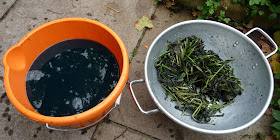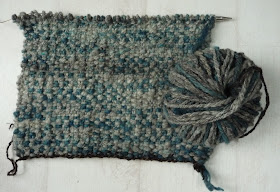"Mmm, Jaeger. Since when did you ever invest in any quality wardrobe pieces?"
My companion, Elinor Gotland, was helping me sort through my felt collection.
"Oh, I got that purple top in a sale, years ago. I used to wear it and then just hang it up to air. Pure wool, dry clean only. When I finally tried running it through the wool wash cycle, it felted."
"You Slack Alice. What happened to the green M&S jumper? An accidental boil?"
"Himself got oil stains on it, so I felted that on purpose. Before you ask, the yellow is proper felted wool, left over from an offcut I bought to make a banner."
"Fair play. And with what will you require my assistance today, madam - making more bunting, is it?"
"Jerkin."
"How rude. You're on your own with that, Beaut."
"No, making a jerkin, a sleeveless jacket a bit longer than a waistcoat."
"Oh, a gilet. Nice idea, shame the dog is more use with a sewing machine than you."
"Actually, I have a cunning plan, pinched from my Mum. She used her weaving to make a lovely gilet, hardly any sewing involved, just using woven fabric 25cm wide. Like the selvedges of her weaving, this felt won't fray, all I need to do is cut it into strips 25cm wide."
The longest single strip I could get out of the green jumper was 56cm, so that was the length of the back decided. Leaving the
lowest 24cm open as a vent, the 56cm green strip and a 56cm yellow strip were sewn together along the midline using saddle stitch. The purple piece was far longer. Finding the midpoint by folding it in half and laying it centrally, overlapping the top of the green and yellow back by 1cm, one more seam joined all three pieces together. The purple strip forms a wide collar, then
comes down each side to make the front panels of the jacket. If you had a long enough top strip, all you would need to do is pin it to the outside edges of the back, try it on to work out how much armhole space should be left open at the top, then sew up the sides. Since I was going to have to sew on spare strips of yellow and green felt to make the front long enough, I thought I might as well make a virtue of it
and fold the extra pieces up into pockets. Unfortunately, the weight of the doubled pockets strained the purple felt and made the front hang badly, so I needed to cut a band of reinforcement felt to sew all around the front edge. More sewing than planned, still, no regrets, I finished it in the car on the way to Spinning Camp, where it was much admired.
The good sized pockets easily held my phone,
fags,
scissors, wool, spare tent peg and so forth and the felt was warm, ideal for early autumn.
My companion was too busy to come camping this time. Probably auditioning for The Great British Celebrity Sewing Bee. Next Spinning Camp will be 9 - 18 June 2017. Come and join us, details on Ravelry, Happy Campers UK forum.
My companion, Elinor Gotland, was helping me sort through my felt collection.
"Oh, I got that purple top in a sale, years ago. I used to wear it and then just hang it up to air. Pure wool, dry clean only. When I finally tried running it through the wool wash cycle, it felted."
"You Slack Alice. What happened to the green M&S jumper? An accidental boil?"
"Himself got oil stains on it, so I felted that on purpose. Before you ask, the yellow is proper felted wool, left over from an offcut I bought to make a banner."
"Fair play. And with what will you require my assistance today, madam - making more bunting, is it?"
"Jerkin."
"How rude. You're on your own with that, Beaut."
"No, making a jerkin, a sleeveless jacket a bit longer than a waistcoat."
"Oh, a gilet. Nice idea, shame the dog is more use with a sewing machine than you."
"Actually, I have a cunning plan, pinched from my Mum. She used her weaving to make a lovely gilet, hardly any sewing involved, just using woven fabric 25cm wide. Like the selvedges of her weaving, this felt won't fray, all I need to do is cut it into strips 25cm wide."
The longest single strip I could get out of the green jumper was 56cm, so that was the length of the back decided. Leaving the
lowest 24cm open as a vent, the 56cm green strip and a 56cm yellow strip were sewn together along the midline using saddle stitch. The purple piece was far longer. Finding the midpoint by folding it in half and laying it centrally, overlapping the top of the green and yellow back by 1cm, one more seam joined all three pieces together. The purple strip forms a wide collar, then
comes down each side to make the front panels of the jacket. If you had a long enough top strip, all you would need to do is pin it to the outside edges of the back, try it on to work out how much armhole space should be left open at the top, then sew up the sides. Since I was going to have to sew on spare strips of yellow and green felt to make the front long enough, I thought I might as well make a virtue of it
and fold the extra pieces up into pockets. Unfortunately, the weight of the doubled pockets strained the purple felt and made the front hang badly, so I needed to cut a band of reinforcement felt to sew all around the front edge. More sewing than planned, still, no regrets, I finished it in the car on the way to Spinning Camp, where it was much admired.
The good sized pockets easily held my phone,
fags,
scissors, wool, spare tent peg and so forth and the felt was warm, ideal for early autumn.
My companion was too busy to come camping this time. Probably auditioning for The Great British Celebrity Sewing Bee. Next Spinning Camp will be 9 - 18 June 2017. Come and join us, details on Ravelry, Happy Campers UK forum.










































